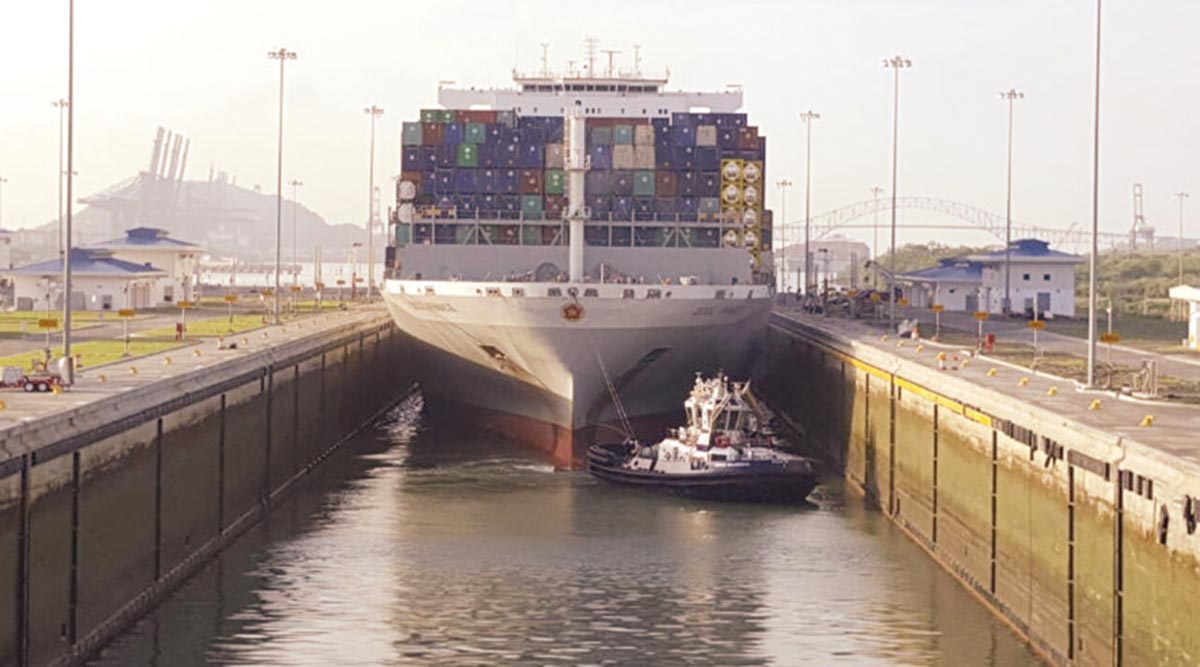Truckers, Ports Rush to Keep Pace as Bigger Ships Cross Panama Canal

This story appears in the June 5 print edition of Transport Topics.
Just weeks after the Cosco Development became the largest ship to traverse the Panama Canal since the expansion nearly one year ago, the OOCL France shattered the record en route from Asia to the East Coast as part of the new weekly service from the Ocean Alliance.
The vessel from the Orient Overseas Container Line crossed the canal May 24 with 13,926 industry-standard 20-foot-equivalent units, or TEUs, slightly more than the 13,345 on the Cosco Development in early May.
The OOCL France, like the Cosco Development, is about 1,200 feet long and 158 feet wide — more than 100 feet longer than the U.S. Navy’s newest aircraft carrier, the USS Gerald R. Ford.
While other vessels could eclipse the record, Panama Canal officials estimate the maximum size that would fit through the expanded locks is 14,000 TEUs.
“This trend towards the transit of 13,000-TEU or greater vessels demonstrates the acceptance and trust that the shipping industry has with the service provided by the expanded canal,” Panama Canal Administrator Jorge Quijano said.
For the trucking companies, the OOCL France, Cosco Development and other Neopanamax vessels will offer more demand for inland drayage. However, they also pose a new challenge: how to haul a high volume of containers unloaded in a single stop rather than spread out over several trips.
“We’ve had to adjust the schedules of our drivers’ shifts. A majority of our customers run a very lean supply chain and look for their freight to be delivered immediately after vessel discharge,” said Dave Manning, president of Nashville, Tenn.-based TCW Inc., which operates in Charleston, S.C., and Savannah, Ga. “With more containers arriving on the same vessel, rather than spread out among two or three vessels, we are forced to be very efficient in our dispatch plan to cover all of our clients’ needs in a much shorter time window. Things will get interesting from a truck and driver capacity standpoint as more of the larger vessels show up.”
Ken Kellaway, CEO of RoadOne IntermodaLogistics, argued that the bigger vessels will put considerable strain on the entire system due to limitations of the storage space at terminals, truck capacity and an “inability to feed volume of trucks to meet short term spikes.”
“We only have so many trucks every day. We need to keep them running consistently, rather than be busy for three days and then slow again,” he said.
RoadOne IntermodaLogistics, based in Randolph, Mass., ranks No. 8 on the Transport Topics sector list of the top U.S. and Canadian intermodal and drayage carriers.
The Ocean Alliance’s weekly South Atlantic Express service consists of 11 Neopanamax vessels, which stop at ports in Charleston, Norfolk, Va. and Savannah.
East Coast ports are rushing to keep pace, dredging deeper into the waterways still too shallow for larger vessels to navigate unless they are carrying lighter loads or traveling at high tide.
Last month, the U.S. Army Corps of Engineers awarded the South Carolina Ports Authority $17.5 million in construction funding for the Charleston Harbor Deepening Project, scheduled to begin this fall. The agency also awarded the port $16.1 million in operations and maintenance dollars for the routine work necessary to let construction begin. The state government has kicked in $300 million.
The dredging project will make the Charleston Harbor 52 feet deep, to make it possible to accommodate larger vessels without tidal restrictions.
“This is monumental news for the Charleston Harbor Deepening Project,” said Pamela Lackey, SCPA board chairwoman, acknowledging the efforts of Gov. Henry McMaster and the South Carolina congressional delegation.
“The significance of this funding for the timeline of our deepening project cannot be overstated. It is tremendous news for Charleston,” Port Authority CEO Jim Newsome said.
President Donald Trump’s budget would give $58 million to the Port of Boston, $50 million to Savannah and more than $17 million to the Port of Jacksonville, Fla., to deepen harbors.
Politicians from Georgia were unhappy because it was only half of what officials asked to continue to dredge to 47 feet in Savannah, due to be complete in 2020.
Sen. Johnny Isakson (R-Ga.) said in a statement that he was “disappointed by the failure of the Army Corps of Engineers” to route some of the discretionary funds to Savannah.
“Rest assured that I will continue fighting in Congress to secure sufficient funding for this worthy project to be completed without further delays,” Isakson said.
For projects in the planning stages, $2.8 million will go to Port Everglades in Fort Lauderdale, Fla., and $557,000 for the Sabine-Neches waterway that serves three Texas ports.
Four East Coast ports — Norfolk, Baltimore, New York-New Jersey and Miami — have the water depth necessary to unconditionally handle Neopanamax vessels, generally at least 45 feet.
The Associated Press contributed to this report.

